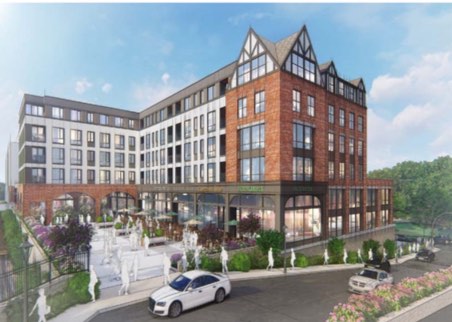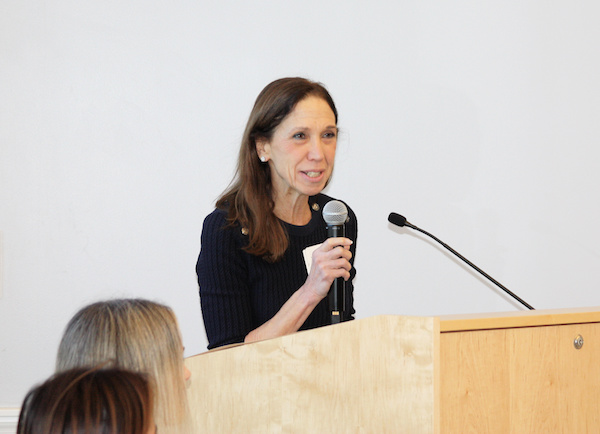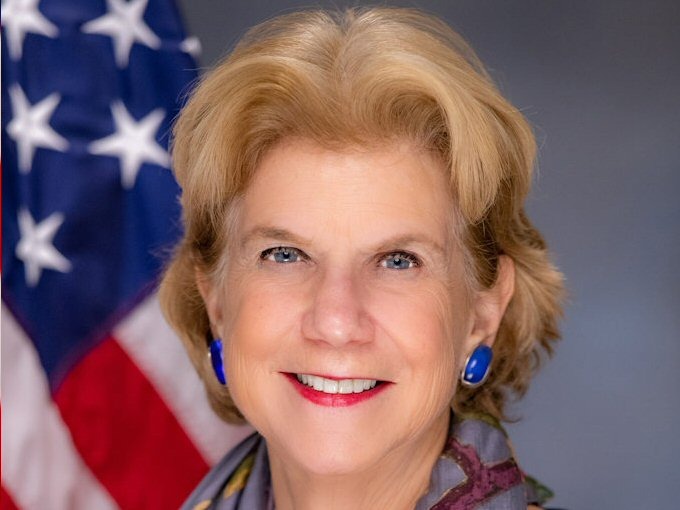Hochul Proposes Ambitious Development Requirements for Suburban Communities
- Category: On Our Radar
- Published: Wednesday, 08 February 2023 13:24
- Joanne Wallenstein
 Imagine Fox Meadow Road and Walworth Avenue lined with three story apartment buildings, rather than single family homes set 30 feet from the curb. That’s what new legislation outlined in the Governor’s budget proposal could mean for suburbs like Scarsdale who are served by Metro North. As a part of an initiative to build 800,000 more homes in the state in the next decade, Hochul is setting her sights on suburban communities that are primarily zoned for single family homes.
Imagine Fox Meadow Road and Walworth Avenue lined with three story apartment buildings, rather than single family homes set 30 feet from the curb. That’s what new legislation outlined in the Governor’s budget proposal could mean for suburbs like Scarsdale who are served by Metro North. As a part of an initiative to build 800,000 more homes in the state in the next decade, Hochul is setting her sights on suburban communities that are primarily zoned for single family homes.
The proposal includes two distinct provisions.
First, Hochul proposes to build more housing and would require Scarsdale to increase housing stock by 3%, or about 180 units, every three years.
The second provision requires municipalities to make changes to their zoning laws to permit multifamily housing within a ½ mile radius of a train station. Train stations within 15 miles of New York City would fall into “Tier 1” of the proposal, which would allow up to 50 units to be built for each acre. Both the Scarsdale and Hartsdale train stations would fall into Tier 1. This second provision clears the way for developers to purchase available land and build up to 50 units per acre in areas that were originally zone for single family homes.
Scarsdale debated a transit oriented development project for the 2.5 acre Freightway Site from 2017-2020, when six developers were invited to present proposals for a mixed use development project. Some included up to 300 apartments, which would have met the state mandate for growth for one three year period. Ultimately, as a result of residents’ fears about a rise in the school population, traffic and congestion, the project was put on hold. Now, faced with pressure to supply additional homes, the Village Board may seek to reopen the discussion.
The blanket order does not address how localities could address strained infrastructure to support the new dwellings, an increased school population and the need for parking. These are just some of the concerns of the officials and residents when considering an override to local building code to accommodate increased home density.
Hochul’s new provisions would need to be passed by the NYS Assembly and the NYS Senate and it is yet to be seen whether lawmakers will be persuaded to vote yes despite their constituents objections. Some are wondering if a better approach by the Governor would have been to offer incentives such as state aid and tax breaks for development rather than a punitive approach.
Remedies and Penalties
What if there is no available land or it is not economically attractive for developers to build additional units? In those cases the Governor’s proposal offers alternative methods of meeting the 3% growth threshold where development is not possible.
It specifies that if a locality fails to comply with the building targets, they can achieve “Safe Harbor” by taking other land use actions to increase housing including:
-Legalizing accessory dwelling units (ADUs)
-Facilitating lot splits (subdivisions)
-Removing the following exclusionary measures: minimum lot size requirements, unreasonable height limits and lot coverage restrictions and parking minimums
-Smart growth – rezoning one-third of developed land of a municipality for 25 units/acre
-Adapting reuse rezoning to allow residential density of at least 25 units per acre in an area of at least 100 acres that only allowed commercial use
And for municipalities who fail to meet the growth objectives after January 1, 2027 the state would mandate approval for projects where at least 20 percent of units are affordable to very low-income households (at or below 50 percent AMI) or 25 percent affordable to low-income households (at or below 80 percent AMI) and are at least 20 units or more downstate. Builders of these projects could apply for local approval despite existing zoning and cannot be denied because of it.
Further, these projects would be exempt from State Environmental Quality Review Act (SEQR) and review is limited to local infrastructure capacity and published, objective aesthetic standards. A decision must be made on these applications within 120 days if under 100 units or within 180 days if over 100 units. If a locality fails to make a decision or imposes conditions that make the project economically infeasible, it will be considered a denial.
Qualified projects denied a permit could pursue a new appeals process that places the burden of proof on the locality. If the locality denied the projects, developers could appeal to a newly created housing review board or file a land use appeal with the supreme court.
Looking Back
This is not the first time lawmakers have attempted to force new development in suburban communities. In fact, similar measures were included in Hochul’s 2022 budget. Legislation was introduced to allow the override of local zoning to permit the building of Accessory Dwelling Units (ADU’s) in the NYS Senate but failed to pass. A second bill requiring multifamily housing within a half mile of train stations also met with opposition.
Hochul withdrew the ADU provisions from her budget after receiving pushback from localities but said, “I believe that increasing our housing supply is essential to the growth of our economy, to reaching our lower carbon footprint, to achieving our goals of equity and inclusion and to addressing the affordability challenges faced by so many New Yorkers.”
And in 2009, the Anti-Discrimination Center of New York won a settlement against Westchester County ordering the county to spend $51.6 million to build 750 units of affordable housing over the next seven years. In 2015 monitor Federal Monitor James Johnson said the county had violated that settlement and fallen short of targets. In 2016 Johnson resigned.
 Jamaal BowmanWe asked our local lawmakers for comments on the proposal and here is what they shared:
Jamaal BowmanWe asked our local lawmakers for comments on the proposal and here is what they shared:
Congressman Jamaal Bowman cheered the proposal, saying, “I am glad to see Governor Hochul take this first step to expand housing opportunities for all New Yorkers, including in communities like Scarsdale. As a former educator, I know firsthand the toll that housing insecurity takes on children and their families. Children should be worried about losing their homework, not losing their homes.
I look forward to working with my colleagues at the federal level to reinforce these efforts — and secure stable, affordable housing for marginalized communities, in areas that would otherwise be out of reach.”
However Assemblywoman Amy Paulin was more aware of what increases of this magnitude could do to Scarsdale. She said, “Scarsdale and  Amy PaulinEdgemont wouldn’t be able to accommodate so many new housing units, or even a fraction of the amount required. It would change the character and integrity of our community. Scarsdale would no longer be a Village in a Park. We would be a congested urban center without the infrastructure to support it. I will fight to make sure this doesn’t happen.”
Amy PaulinEdgemont wouldn’t be able to accommodate so many new housing units, or even a fraction of the amount required. It would change the character and integrity of our community. Scarsdale would no longer be a Village in a Park. We would be a congested urban center without the infrastructure to support it. I will fight to make sure this doesn’t happen.”
And State Senator Shelley Mayer recognized the complexities of the mandate for diverse communities. She said, ““I commend Governor Kathy Hochul’s commitment to addressing the affordable housing crisis in New York in her proposed budget and look forward to working together with her on this critical issue. Here in Westchester, it remains one of our greatest challenges.
 Shelley Mayer“The Governor’s proposals seek to walk a fine line between state enforcement and local control over housing policy, but I remain concerned that the voices of local municipal officials and individual communities have not been adequately reflected in these proposals. In addition, the significant differences between all of New York’s diverse communities must be adequately addressed, both as to affordable housing and transit oriented development. I urge the Governor to engage in direct conversation with municipal officials throughout the state to find acceptable solutions that work for our communities, and recognize the steps many have taken to increase affordable options.
Shelley Mayer“The Governor’s proposals seek to walk a fine line between state enforcement and local control over housing policy, but I remain concerned that the voices of local municipal officials and individual communities have not been adequately reflected in these proposals. In addition, the significant differences between all of New York’s diverse communities must be adequately addressed, both as to affordable housing and transit oriented development. I urge the Governor to engage in direct conversation with municipal officials throughout the state to find acceptable solutions that work for our communities, and recognize the steps many have taken to increase affordable options.
“Over the next few weeks, with my colleagues, I will continue to analyze the details of this expansive housing plan, and will work with all of my local communities to find solutions that work for them and their residents.”







